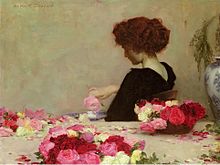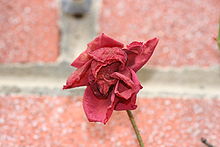
Potpourri (/ˌpoʊpʊˈriː/ POH-puurr-EE) is a mixture of dried, naturally fragrant plant materials used to provide a gentle natural scent, commonly in residential settings. It is often placed in a decorative bowl.
Etymology
The word "potpourri" comes into English from the French word pot-pourri. The French term has two connotations. It is the French name for a Spanish stew with a wide variety of ingredients called olla podrida, a specialty of the city of Burgos. The word pot in French has the same meaning as it does in English (and as olla does in Spanish), while the word pourri, like Spanish podrida, means "rotten". "Potpourri" is sometimes used as an alternative for "medley".
History

Potpourri has been used in rooms since ancient times, in a variety of ways, including just scattering it on the floor. In early 17th-century France, fresh herbs and flowers were gathered—beginning in spring and continuing throughout the summer. The herbs were left for a day or two to become limp, then layered with coarse sea salt. The aging mixture was stirred occasionally as layers were added to it. Often the mixture would ferment or even mold as the summer went by. In fall, spices would be added to the unsightly grey mix until a pleasant fragrance was achieved. Then, scent-preserving fixatives (see below) were added. The finished potpourri was set out in special pots with perforated lids to perfume rooms.
Much modern potpourri consists of any decoratively shaped dried plant material (not necessarily from scented plants) with strong natural and synthetic perfumes (and often colored dyes) added, with the scent often bearing no relation to the plant material used. Sometimes, items that do not originate from plants are mixed in with the potpourri, to give it bulk and to make it more aesthetically pleasing. It is possible to spray scents onto potpourri; however, a fixative is needed so that the scent is absorbed for slow release. Generally, orris root is used for this purpose.
Lifespan
| This section does not cite any sources. Please help improve this section by adding citations to reliable sources. Unsourced material may be challenged and removed. (September 2022) (Learn how and when to remove this message) |
Dried flowers can last anywhere from two months to 20 years, depending on the chosen blend. Properly made potpourri will last longer when stored in closed containers.
Containers
In ceramics manufacturing, a potpourri vase is specifically designed for holding potpourri. In the traditional designs, a potpourri container is provided with a pierced fitted lid, through which the scent may slowly diffuse. The porcelain Sèvres pot-pourri vase in the shape of a ship is one of the most spectacular examples from the 1750s and 1760s; Madame de Pompadour owned three of the twelve examples made, ten of which survived.
Plants used

Many plant species are used in potpourri. A 2015 study from the Royal Botanic Gardens, Kew identified 455 species used in potpourri from over 100 families, including algae, fungi, and lichens. A few toxic ingredients have been found in fruits such as Strychnos nux-vomica, the strychnine tree. Plant materials used in potpourri include:
- Allspice
- Cedar wood shavings (toxic, a moth repellent)
- Cinnamon bark and cassia bark, which smells like cinnamon, only less potent
- Cloves
- Cypress wood shavings (toxic, another moth repellent)
- Fennel seed
- Incense-cedar wood shavings
- Jasmine flowers and oil
- Jujube flowers and blooms
- Juniper wood shavings (toxic, a moth repellent)
- Lavender leaves and flowers
- Lemon balm leaves and flowers
- Lemon peel
- Marjoram leaves and flowers
- Mignonette leaves and flowers
- Mint leaves and flowers
- Mugwort (toxic, adds a musky note to the mix, another moth repellent)
- Orange peel
- Pelargonium leaves from the scented varieties
- Pinyon pine shavings and cones
- Rose flowers, hips, or oil
- Rosemary leaves and flowers
References
- "The Putrid Origin of 'Potpourri'". Merriam-Webster. Archived from the original on 2016-12-15. Retrieved 2022-01-03.
- Merriam-Webster Online dictionary
- Grant, Amy. "Potpourri Garden Plants: Creating A Potpourri Herb Garden". Gardening Know How. Archived from the original on 2018-03-19. Retrieved 2022-01-03.
- "Sèvres porcelain factory - Pot-pourri vase and cover (pot-pourri à vaisseau or pot-pourri en navire)". www.rct.uk. Retrieved 2024-12-13.
- Cook, Frances E. M.; Leon, Christine J.; Nesbitt, Mark (December 2015). "Potpourri as a Sustainable Plant Product: Identity, Origin, and Conservation Status1". Economic Botany. 69 (4): 330–344. doi:10.1007/s12231-015-9325-8. ISSN 0013-0001. S2CID 7060233.
- "Archived copy" (PDF). Archived from the original (PDF) on 2015-09-10. Retrieved 2017-10-31.
{{cite web}}: CS1 maint: archived copy as title (link)